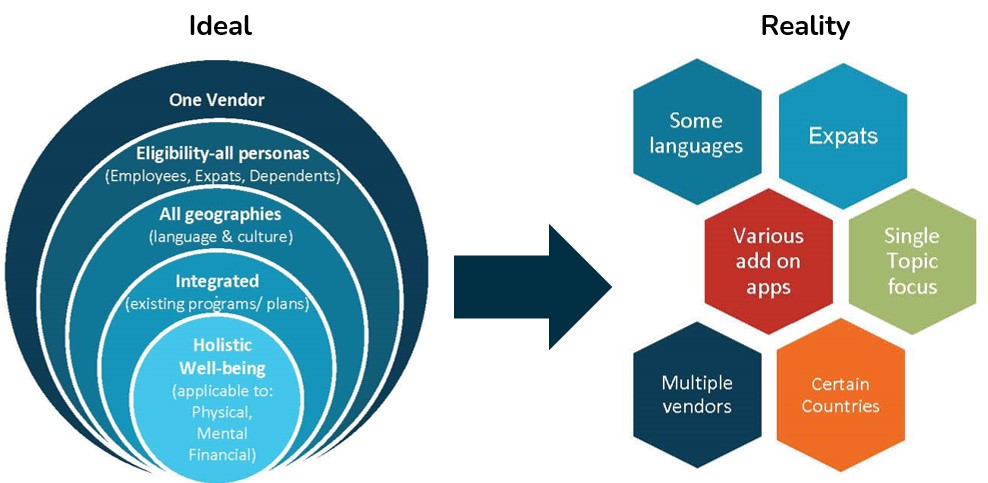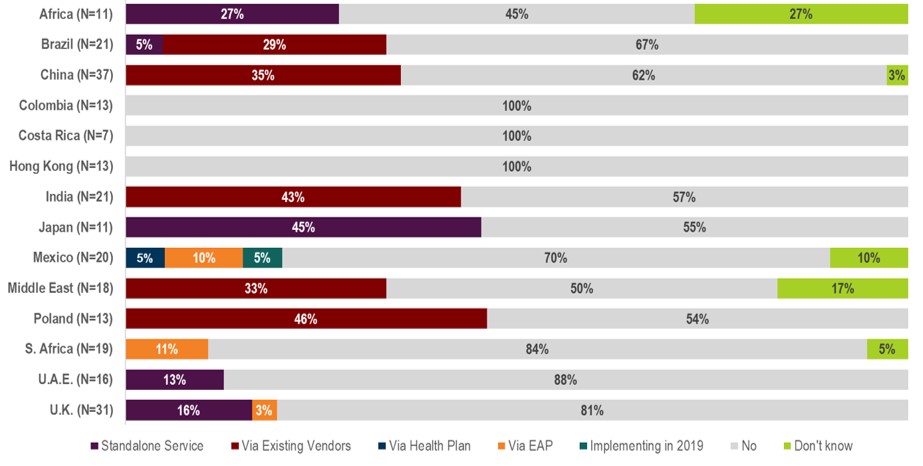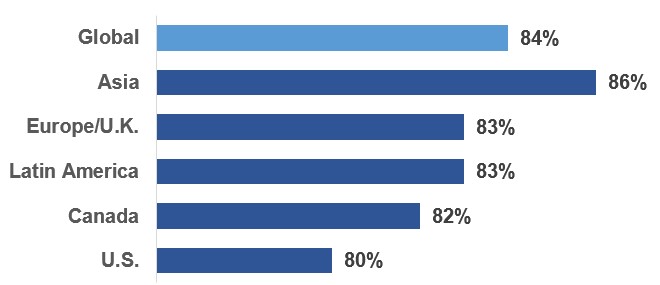November 18, 2021
Employers are increasingly interested in finding global virtual solutions for their workforce. While the market is not very mature, employers started to see a better employee experience locally/regionally, as well as an uptick in virtual solution services, to address market needs during the COVID-19 pandemic.1 Given the state of the market and employers’ limited resources, there are considerations employers should incorporate as they pursue virtual solutions for their employees worldwide.
Current Global Solutions Are Not Mature
While the growth in telehealth has been considerable, it has been fragmented, leading to a strong interest in having one global solution. Global companies with limited resources are looking for fewer vendors in this space to make virtual care consistent and integrated into their broader benefit plans. Having individual point solutions in multiple markets is not sustainable for global benefit management where resources are tight (Figure 1).

Furthermore, telehealth offered by global employers is often part of existing local benefit services (e.g., health plan, EAP) if it is offered at all (Figure 2). Much virtual care is driven at the local level, with startups and local health care vendors building tools relevant to their local populations’ needs and aligned with the regulatory environment.2
The telehealth offerings currently in the global market, however, are only in English and have substantial limitations, with much innovative functionality limited to only the U.S. market. Some employers are working with vendors to build out their global offerings by offering services in multiple languages.

Source: Global Numbers You Need
COVID-19 Has Exponentially Increased Telehealth Services
Table 1 defines the types of virtual solutions currently in the marketplace or under development.3
Table 1: Types of Virtual Solutions
| Virtual Consultations | Consumer Tools |
|---|---|
|
Virtual urgent care (traditional telemedicine): Handling generalized and specialized urgent care needs with on-demand medical consultation Virtual primary care: Enables ongoing relationship with clinician delivered (either virtual only or hybrid model with primary care doctor who also has a physical location) Virtual expert second opinion: Consultation with expert resource in relevant specialty for complex care situations to offer or confirm diagnosis and appropriateness of treatment recommendation |
Digital remote monitoring for chronic conditions: Digital user input and monitoring devices that feed signals and triggers to broader care team Digital self-help tools: Digital tools to help individuals with self-care for non-clinical needs |
| Digital Therapeutics | Artificial Intelligence Technology |
|
Digital therapies: Evidence-based therapeutic interventions leveraging software to prevent, manage or treat a medical condition |
Clinical decision making: AI-driven technology used to support diagnosis, recommending and actioning treatment plans and flagging anomalies |
Source: Aon 2020 Virtual Care: The Next Era in Healthcare
The COVID-19 pandemic provided an opportunity for virtual health services to move from an auxiliary service to a critical one sought after by employees.4 According to a 2021 Mercer survey, eight out of ten employees plan to use digital health services during the pandemic (Figure 3).4 Governments around the world have updated regulations to make telehealth services more accessible to their populations unable to see health care providers in person, allowing providers to engage with their patients safely.1, 5, 6 For more information, this DLA Piper guide provides details on regulations of telehealth services at a country level. As an example, to address physician access gaps, China has an artificial intelligence (AI) service designed to assist with triaging care and providing virtual care for common ailments, freeing up doctors to provide more complex care.1 In addition to telehealth apps, health care providers in China have used Wechat and those in India have turned to Whatsapp to provide digital health services.6

NOTE: Employees by region who plan to use telemedicine the same or more than during the pandemic (%)
Value of Virtual Health Solutions
Virtual health solutions can have a positive impact on health care and well-being initiatives in the following ways: 2,3
- Increasing engagement by utilizing gamification to engage people in their health;
- Improving access and obtaining care without having to take time off work;
- Addressing stigma by educating employees on health issues while maintaining privacy;
- Assisting in data collection by collecting self-reported and device-measured data in real time;
- Improving communication by providing information via text and/or app notifications;
- Delivering programs to multiple groups in various locations and providing consistent information;
- Integrating with employees’ real time needs by providing the right information at the right time; and
- Simplifying complicated information by using layman’s terms to address complex care issues.
Employer Considerations
As you think about how to incorporate virtual health solutions into your overall strategy, here are six items to consider:
- Work with a broker or consultant to understand telehealth offerings locally and regionally. This space is rapidly transforming, and it is challenging to keep pace.
- Assess and encourage virtual health solution integration into existing benefits.
- Ensure that virtual solutions incorporate inclusive design (race, LGBTQ+, diversity in imagery, overweight and obesity).
- Work with emerging global vendors to build out their services.
- Engage local and regional colleagues to assess gaps and opportunities and review new services for language and cultural compatibility.
- Fill in gaps in care (mental health) as part of your global consistency strategy.
- 1 | Bodulovic G, Wang S, de Morpurgo M, Saunders EJ. Telehealth around the world: A global guide. DLA Piper. November 2020. https://www.dlapiper.com/en/italy/insights/publications/2020/11/telehealth-around-the-world-global-guide/. Accessed October 4, 2021.
- 2 | Ittig A, Ramos P, Henderson D, Yamamoto S, Alverson D. Telehealth around the world: What’s different & how we are the same. American Telemedicine Association. September 24, 2021. https://www.americantelemed.org/resources/telehealth-around-the-world-whats-different-how-we-are-the-same/. Accessed October 15, 2021.
- 3 | Faircloth J. Virtual care: The next era in healthcare. Aon. October 2020. https://insights-north-america.aon.com/managing-healthcare-costs-finance/virtual-care-the-next-era-in-healthcare. Accessed October 6, 2021.
- 4 | Mercer Marsh Benefits. Health on demand: Delivering the benefits employees want now. 2021. https://www.mercer.com/our-thinking/health/mmb-2021-health-on-demand.html. Accessed October 21, 2021.
- 5 | Bhaskar S, Bradley S, Chattu VK, et al. Telemedicine across the globe-position paper from the COVID-19 Pandemic Health System Resilience PROGRAM (REPROGRAM) International Consortium (Part 1). Frontiers in Public Health, October 16, 2020. https://www.frontiersin.org/articles/10.3389/fpubh.2020.556720/full. Accessed October 4, 2021. Here is the rest of the Virtual Care and COVID-19 Global article series: https://www.frontiersin.org/research-topics/14358/telemedicine-during-and-beyond-covid-19#articles.
- 6 | Harper JJ, Liao T, Heine J, et al. Telehealth use surges around the world amid COVID-19. Morgan Lewis. August 13, 2020. https://www.morganlewis.com/pubs/2020/08/telehealth-use-surges-around-the-world-amid-covid-19-cv19-lf. Accessed October 1, 2021.
- 7 | Seivert S, Badowski ME. The rise of telemedicine: Lessons from a global pandemic. EMJ Innov. February 9, 2021. https://www.emjreviews.com/innovations/article/the-rise-of-telemedicine-lessons-from-a-global-pandemic/. Accessed October 4, 2021.
- 8 | Mastroianni B. How telehealth Is making healthcare more inclusive for millions. Healthline. January 19, 2021. https://www.healthline.com/health-news/how-telehealth-is-making-healthcare-more-inclusive-for-millions. Accessed October 12, 2021.
- 9 | McManus T. Telehealth and virtual health benchmarking call summary. Business Group on Health. March 2019.
- 10 | Sonner J. Innovation in virtual health. Business Group on Health. October 2018.
- 11 | Manguerra M. Using technology to promote financial well-being. Business Group on Health. April 2018.
More Topics
Articles & Guides
This content is for members only. Already a member?
Login
![]()
